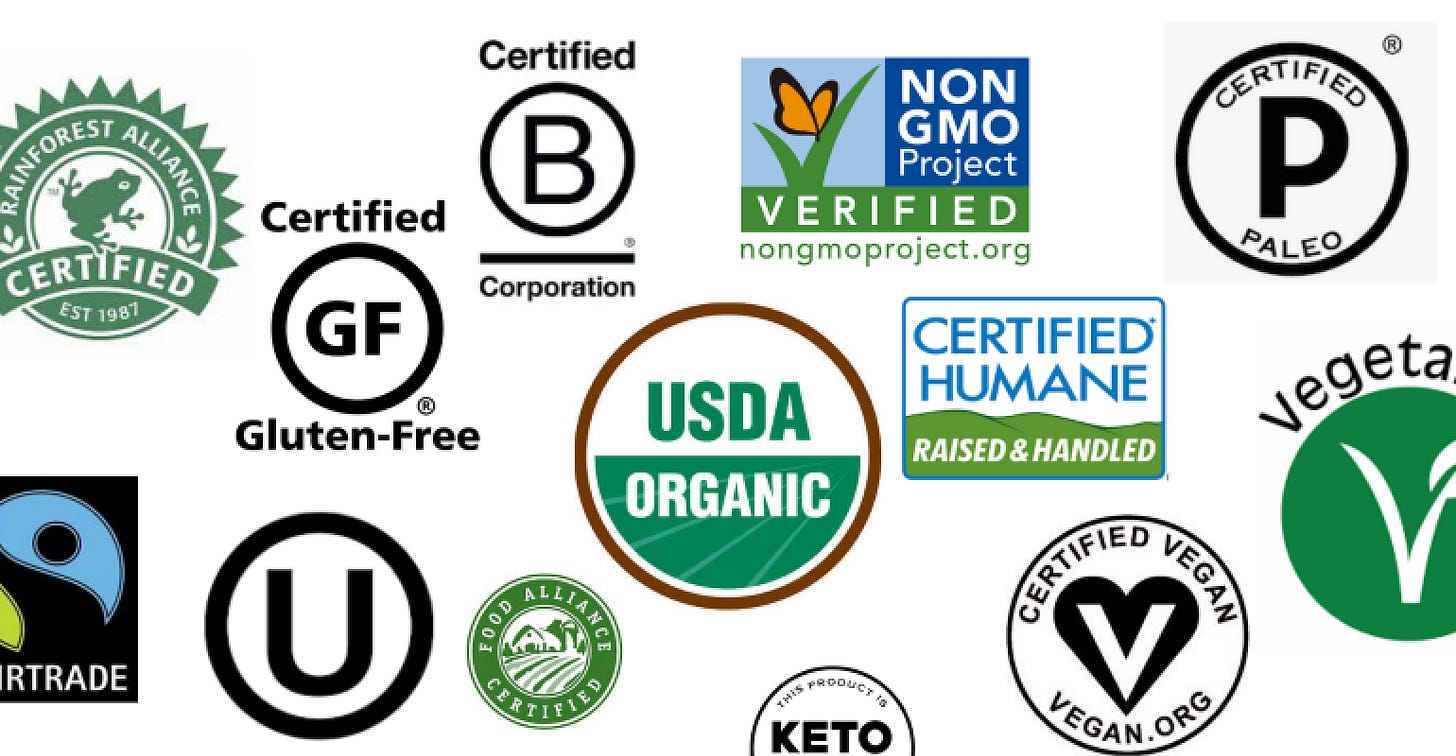✔️ Behind the certification
Policy: It is hard to walk down a grocery aisle without noticing labels like Non-GMO, Rainforest Alliance Certified, Organic, Certified Transitional, Whole30, Certified Humane, and 100% Grass-Fed plastered on the front of our favorite brands. In last week’s newsletter, we mentioned that many critics view the US Department of Agriculture’s National Organic Program (NOP), and many other certifications for that matter, as less of a health or welfare standard and more of a marketing scheme. For a sustainable farmer to showcase their ethical and ecological commitments, they must first file lengthy applications and pay steep fees towards accredited land auditors.
In lieu of a universal definition, regenerative agriculture has existed for decades as a farming philosophy that works in partnership with nature to produce nutrient-dense food that restores the ecosystem it was grown in. But at this very moment, there are at least five regenerative labels in the works. The Regenerative Organic Certification (ROC), which applies to any product made with agricultural ingredients, is the closest to industry-wide adoption. The ROC standards are based around three pillars: ecosystem health, animal welfare, and fair labor practices. Food, fuel, and fiber producers are evaluated at three tiers - bronze, silver, and gold. And participants must gradually make improvements to progress through the levels.
The ROC was first conceptualized back in 2018 by the Regenerative Organic Alliance (ROA) - a group of companies and organizations including the Rodale Institute, Dr. Bronner’s, and Patagonia. With the idea of designing “one standard to rule them all,” the ROC blends best practices from pre-existing standards, as well as new criteria, into one standard. And on the surface, its goals are in alignment with those of sustainable agriculture proponents. However, the introduction of the ROC has not come without controversy. The new label is already garnering criticism because it:
Adds confusion to a crowded marketplace: The Organic Trade Association (OTA) warns that the ROC poses a risk to the success of the USDA Organic label because of the overlap between two of the three pillars - soil health and animal welfare. In its ROC comments, General Mills - the fourth-largest producer of organic and natural foods - said that "we are concerned that yet another eco-label, with multiple tiers within, will further complicate the landscape of [third-party] labels for consumers.” A similar sentiment was echoed by Stonyfield, the largest US producer of organic yogurt. The company believes that it will be hard to explain why the ROC certification is needed without confusing consumers.
Is only accessible to a small subset of producers: The USDA Organic certification (or an international equivalent) is a baseline requirement for the ROC. ROC-certified producers must then meet “regenerative” criteria - including crop rotation, rotational grazing, livestock feed from regenerative sources, protections for workers against wage theft, and more. To cover the auditing costs of the ROC, farms pay a fee of 0.1 percent of sales while brands cough up 0.2 percent of sales. Thus, the ROC is only relevant to a tiny fraction of producers who operate a small portion of farmland across the US. And only the most affluent consumers can purchase ROC products, which inevitably cost more than their organic counterparts.
Perpetuates a practice-based structure: Similar to the NOP, and other prominent standards, the ROC is currently enforcing a practice-based structure. Instead of measuring for positive ecological outcomes, a practice-based standard constrains producers by mandating what they can and cannot do. In contrast, a standard based on measurable outcomes grants producers the freedom to use creative practices specific to their operation.
Overall, a new standard that tackles the issues of sustainable farming, animal welfare, economic justice, and fair labor practices is not a bad thing. We must also recognize that enforcing strict standards and steep fees along the lines of the ROC has the potential to squash innovation and create a food system where regenerative goods are inaccessible to 99% of consumers. With it only being the third year of the ROC, there is time for the ROA to refine the standard and develop its cost-share program that supports farmers making the transition to regenerative practices. Until then, we would love to hear your thoughts on the ROC framework!
Read: In The Third Plate, Dan Barber explores the evolution of the US food system and how it must transition to a cuisine rooted in “seasonal productivity, natural livestock rhythms, whole-grains, and small portions of free-range meat.” Barber is a critically acclaimed author and the co-owner of New York’s Blue Hill at Stone Barns, where he practices close-to-the-land cooking married with stewardship of the earth. Through his nonprofit, Stone Barns Center for Food and Agriculture, Barber is able to bring the principles of sustainable farming directly to the table. If you don’t have time to read the book, Barber’s Ted Talks are an easy way to hear his views on agricultural policy and the future food system.
Shop: Happy Regen-uary, a new initiative encouraging consumers to source food more responsibly. Before the month comes to an end, we are excited to share that our friends at Wholesome Meats are rewarding one lucky person with a $500 store credit. Click the link to learn more about how to enter the national giveaway. Want to taste the regenerative difference first? Wholesome Meats is also debuting two new ways for our readers to save on their premium meat. Look no further than the Starter Pack for a selection of ground beef and prime cuts. Or try out the Steak Sampler, which includes a medley of prime cuts - including ribeye, tenderloin filet, New York strip, and more. Don’t forget to use the code “BIG15” at checkout to receive 15% off your next order!
The Regeneration is brought to you by PastureMap | Soilworks | Wholesome Meats.



